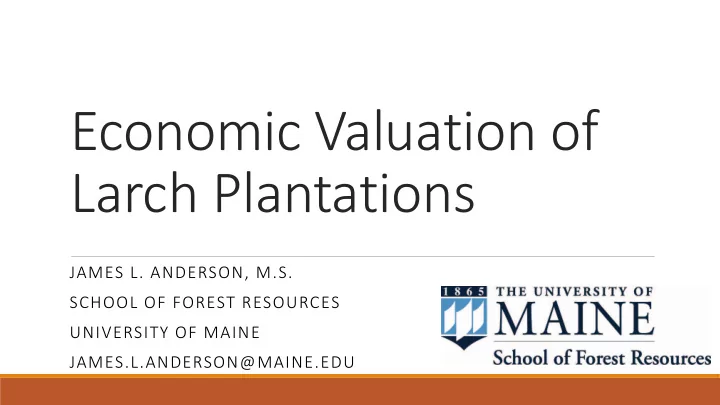

Economic Valuation of Larch Plantations JAMES L. ANDERSON, M.S. SCHOOL OF FOREST RESOURCES UNIVERSITY OF MAINE JAMES.L.ANDERSON@MAINE.EDU
Plum Creek Larch Plantation Data Site ID No. of DBH Measurement HGT Measurement Species Trees Ages Ages Chase Stream SR 8801 370 5, 10, 16, 20 3, 5, 10, 16, 20 All (EL, HL, JL, TL) Carrying Place SR 8801 359 3, 5, 10, 16 3, 5, 10, 16 All (EL, HL, JL, TL) Brighton SR 8801 472 3, 5, 10, 16 3, 5, 10, 16 All (EL, HL, JL, TL) Lily Bay SR 8801 355 3, 5, 10, 15 3, 5, 10, 15 All (EL, HL, JL, TL) West Forks SR 9004 232 6, 10 ,15 2, 5, 6, 10,15 Hybrid Brighton/Hartland TI 9801 900 3, 5, 10 1, 2, 3, 5, 10 Hybrid Hartland TI 9802 1800 3, 5 1, 2, 3, 5 Hybrid North Anson SR 9004 194 6, 10 ,15 2, 5, 6, 10,15 Hybrid
Completing the Data Using Regression Imputation, we fill in missing Heights and Diameters 𝐸𝐶𝐼 𝑗𝑔 𝐸𝐶𝐼 𝑗𝑡 𝑠𝑓𝑑𝑝𝑠𝑒𝑓𝑒 min 𝐹 𝐸𝐶𝐼 𝐼𝑓𝑗ℎ𝑢, 𝐵𝑓, 𝑇𝑞𝑓𝑑𝑗𝑓𝑡, 𝑉𝑜𝑗𝑢 + ε 𝐼𝑢 , 0.0001 𝑗𝑔 𝐼𝑓𝑗ℎ𝑢 𝑗𝑡 𝑠𝑓𝑑𝑝𝑠𝑒𝑓𝑒 𝐸𝐶𝐼 = min(𝐹 𝐸𝐶𝐼 𝐵𝑓, 𝑇𝑞𝑓𝑑𝑗𝑓𝑡, 𝑉𝑜𝑗𝑢 + ε, 0.0001) 𝑝𝑢ℎ𝑓𝑠𝑥𝑗𝑡𝑓 𝐼𝑓𝑗ℎ𝑢 𝑗𝑔 𝐼𝑓𝑗ℎ𝑢 𝑗𝑡 𝑠𝑓𝑑𝑝𝑠𝑒𝑓𝑒 min(𝐹 𝐼𝑓𝑗ℎ𝑢 𝐸𝐶𝐼, 𝐵𝑓, 𝑇𝑞𝑓𝑑𝑗𝑓𝑡, 𝑉𝑜𝑗𝑢 + ε 𝐸𝐶𝐼 , 0.0001) 𝑗𝑔 𝐸𝐶𝐼 𝑗𝑡 𝑠𝑓𝑑𝑝𝑠𝑒𝑓𝑒 𝐼𝑓𝑗ℎ𝑢 = min(𝐹 𝐼𝑓𝑗ℎ𝑢 𝐵𝑓, 𝑇𝑞𝑓𝑑𝑗𝑓𝑡, 𝑉𝑜𝑗𝑢 + ε, 0.0001) 𝑝𝑢ℎ𝑓𝑠𝑥𝑗𝑡𝑓
Operational Property Assumptions Tree stems are narrow paraboloids DBH measurement height, DBH.Hgt = 4.5 ft Minimum Diameter at small end for saw logs, sawDSE = 9.0 in Minimum Diameter at small end for biomass, bioDSE = 3.5 in Fraction of Unusable Sawlog Volume, cull = 0.100 Density of Larch, ton.p.ft3 = .024 tons/ft 3 We can earn 3% yield on 30yr US bonds, so we want a 4% IRR on our stands
Calculating Stand and Tree Statistics 𝐸𝐶𝐼 𝐶𝑏𝑡𝑓 𝐸𝑗𝑏𝑛𝑓𝑢𝑓𝑠, 𝐸𝑀𝐹 = 1− 𝐸𝐶𝐼.𝐼𝑢 𝐼𝑢 𝑁𝑏𝑦 𝑄𝑠𝑝𝑒𝑣𝑑𝑢 𝐼𝑓𝑗ℎ𝑢, 𝑇𝑏𝑥. 𝐼𝑢 = 𝐼𝑢 ∗ (1 − ( 𝑡𝑏𝑥𝐸𝑇𝐹 𝐸𝑀𝐹 ) 2 ), 𝐶𝑗𝑝. 𝐼𝑢 = 𝐼𝑢 ∗ (1 − ( 𝑐𝑗𝑝𝐸𝑇𝐹 𝐸𝑀𝐹 ) 2 ) 2 𝑄𝑏𝑠𝑏𝑐𝑝𝑚𝑗𝑑 𝑊𝑝𝑚𝑣𝑛𝑓, 𝑊𝑝𝑚 = π 𝐸𝑀𝐹 2 ∗ 𝐶𝑗𝑝. 𝐼𝑢 ∗ 12∗2 1 − ℎ𝑢 𝐸𝑗𝑏𝑛𝑓𝑢𝑓𝑠 𝑏𝑢 ℎ𝑢, 𝐸𝑗𝑏 = 𝐸𝑀𝐹 ∗ 𝐼𝑢 2 𝐸𝑀𝐹 𝐶𝑏𝑡𝑏𝑚 𝐵𝑠𝑓𝑏, 𝐶𝐵 = π ∗ 12∗2 𝑈𝑄𝐵 1237.7 ∗ 𝑈𝑄𝐵 −.343 − 𝑈𝑄𝐵 ∗ 𝐶𝐵 𝑈𝑠𝑓𝑓𝑡 𝑞𝑓𝑠 𝐵𝑑𝑠𝑓, 𝑈𝑄𝐵 = min
Example Breakdown of a Larch Biomass Small Diameter Cutoff (3.5”) Using the maximum saw height, we calculate the number of 16-, 12- and 8 ft logs (6” trim) we Sawlog Small Diameter Cutoff (9”) might cut and the height along the stem where they are cut. Second Log Cut 12’ Using the Diameter equation, we can calculate the diameter at the small end of each log. First Log Cut 16’ Using each log’s length and small end diameter, we can easily estimate board footage using the International ¼” Rule and removing 10% cull (IntBF). Diameter at Breast Height/ 54” height Diameter at Base/ 6” height
Calculating Stand and Tree Statistics 1 𝑔𝑢 3 Convert board footage to cubic feet using 12 𝐶𝐺 conversion We estimate biomass volume with 𝐶𝑗𝑝𝑛𝑏𝑡𝑡 𝑔𝑢 3 = 𝑊𝑝𝑚𝑣𝑛𝑓(𝑔𝑢 3 ) − 𝐽𝑜𝑢𝐶𝐺 ∗ 1 𝑔𝑢 3 12 𝐶𝐺
Predicting Sawlog Volume
Predicting Remaining Biomass
Matching Larch to Products on the Market Using k-nearest neighbors (k = 5), we match six Larch lumber properties for each species reported by Koizumi, Kitagawa, and Hirai (2008), Chui and MacKinnon-Peters (1995), and Olson, Poletika, and Hicock (1947) to lumber properties of common commercial species, available in the USDA’s Wood Handbook (2010). These 10 Maine species are then mapped to stumpage prices provided by MFS. Atlantic White Cedar Cedar Eastern Red Cedar $2.94/ton, $118/MBF Northern White Cedar White Pine Eastern White Pine $2.94/ton, $172/MBF Hemlock: Eastern Hemlock $2.94/ton, $73/MBF Balsam Fir Black Spruce Spruce/Fir: Red Spruce White Spruce $2.94/ton, $205/MBF Red Pine European Larch points in Red Red Pine $2.94/ton, $71/MBF
Matching Larch to Maine Species European ◦ Black Spruce, Red Pine, Eastern Hemlock, Red Spruce, White Spruce Hybrid ◦ Eastern White Pine, Atlantic White Cedar, Balsam Fir, White Spruce, Northern White Cedar Japanese ◦ Eastern Hemlock, Eastern White Pine, Atlantic White Cedar, Balsam Fir, Black Spruce Tamarack ◦ White Spruce, Eastern Hemlock, Red Spruce, Black Spruce, Balsam Fir
Matching Larch to Commercial Species European, $151.80 ◦ Spruce/Fir x 3, Red Pine, Hemlock Hybrid, $154.60 ◦ White Pine, Cedar x 2, Spruce/Fir x 2 Japanese, $163.60 ◦ Hemlock, White Pine, Cedar, Spruce/Fir x 2 Tamarack, $178.60 ◦ Spruce/Fir x 4, Hemlock
Sawlog and Total Value of a Larch Stand
A Comparison with Spruce and Fir Stands SI = 50 SI = 60 SI = 70 Japanese Larch reinvested @ 3%
Under Infinite Rotations: SEV Species ‘Optimal’ Rotation SEV Age Balsam Fir 52 $650 White Spruce 56 $725 Japanese Larch 30 $1180
Conclusions Larch grow quite quickly ◦ Empirically: 2.90 ft/year on average with Hybrid growing an extra 0.41 ft/yr and Tamarack lagging by 0.73 ft/year ◦ DBH growth is roughly 0.16 in/ft of height growth or 0.47 in/year Quality stands of Hybrid Larch may start producing some saw logs at age 18 with poorer sites lagging by about two years Not enough data to determine the optimal financial rotation age, but just growing out to 30 years has good returns Stand value may be even greater with PCT or mortality recovery
Comments and Questions? *** Special thanks to Mindy Crandall, Ph.D., *** ** Adam Daigneault, Ph.D., Lloyd C. Irland, and David Maass ** *** and larchresearch.com for photos ***
Recommend
More recommend